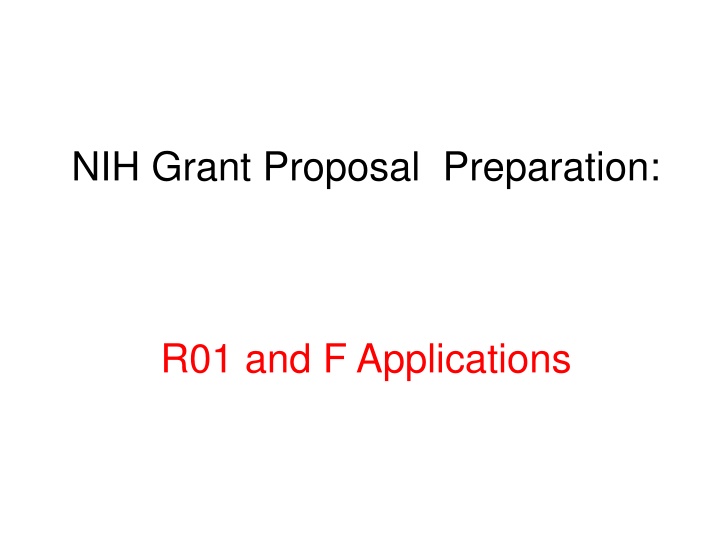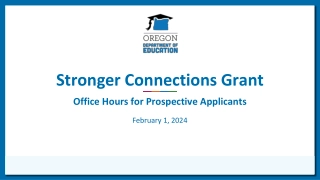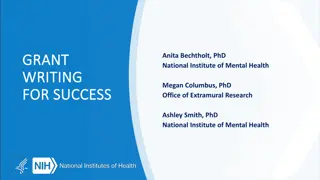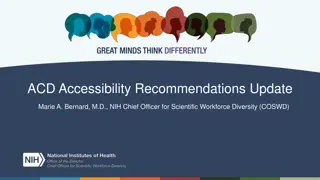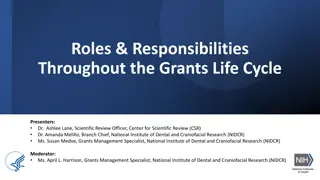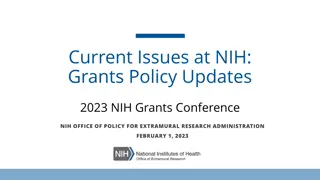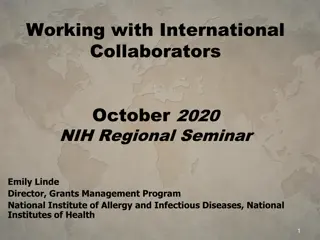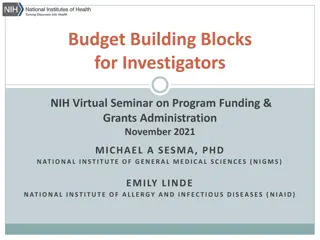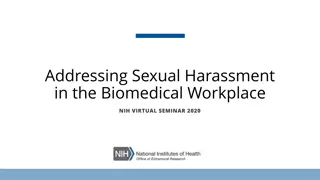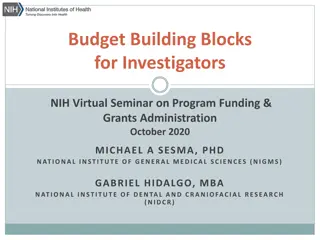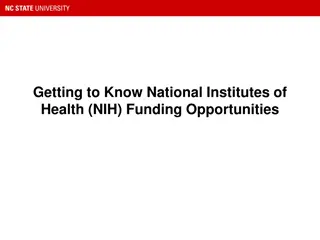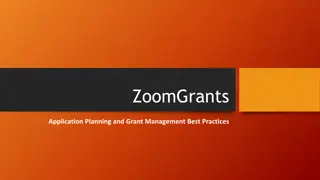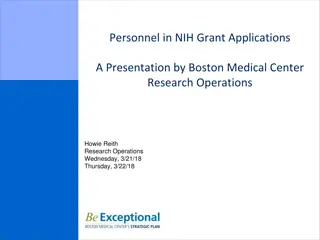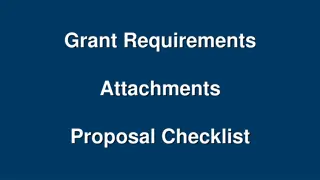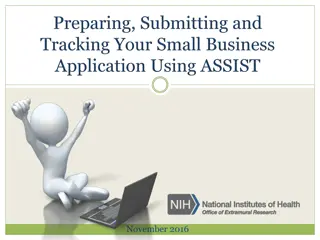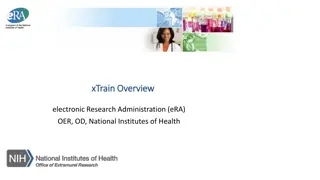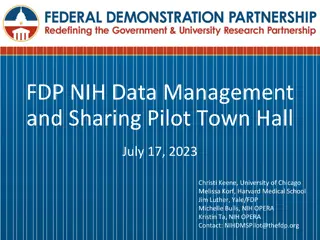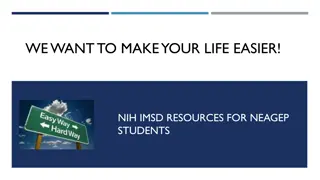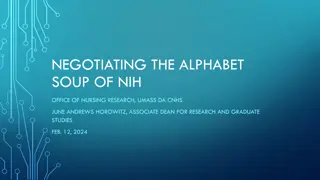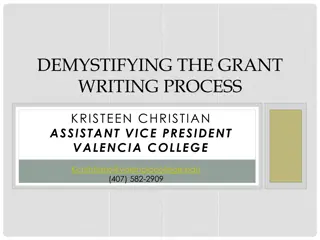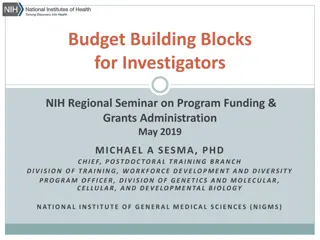NIH Grant Proposal Preparation: General Instructions
Preparing an NIH grant application involves a complex and lengthy process that includes interaction with a grants administration office at your institution. This office can assist you in acquiring a Commons ID for submission and provide specific instructions for preparing the application. Learn how to find funding opportunities and navigate grants.gov for essential application information.
Download Presentation

Please find below an Image/Link to download the presentation.
The content on the website is provided AS IS for your information and personal use only. It may not be sold, licensed, or shared on other websites without obtaining consent from the author.If you encounter any issues during the download, it is possible that the publisher has removed the file from their server.
You are allowed to download the files provided on this website for personal or commercial use, subject to the condition that they are used lawfully. All files are the property of their respective owners.
The content on the website is provided AS IS for your information and personal use only. It may not be sold, licensed, or shared on other websites without obtaining consent from the author.
E N D
Presentation Transcript
NIH Grant Proposal Preparation: R01 and F Applications
Where To Begin: General Instructions
Preparing an NIH grant application is a complex and lengthy process. Some of these steps will involve your interaction with a grants administration office at your institution. A person from this office can assist you in acquiring a Commons ID (which you will require for submission) as well as finding the program announcement for your NRSA application and the specific instructions that you will require to prepare all of the parts. The application is made electronically by submitting documents in Adobe format (you will require the proper Adobe version to complete these, presently versions 9-11) according to specific instructions located in the 424 instruction package. There are two different sorts of information that you will be required to provide in your application. Information of the first sort is administrative and it is to be typed into electronic forms that are a part of the submission package. You will fill out forms in this package in collaboration with institutional grant administrators. A representative of that office is present this morning and is prepared to speak to you. He/she will describe services that this office will provide. Information of the second type relates to the science of your proposal. This information will be prepared as Word documents which you will print as PDFs and then load electronically into the submission package. We have prepared a PowerPoint presentation that will give you some specific instructions as to how each of these documents can be prepared.
I have provided below some general instructions that include grants.gov web sites that you should navigate to obtain application information. Start at grants.gov. or just go to this link: http://www.grants.gov/search/basic.do. You ll have a list of possible searches. Alternatively, go to: http://apply07.grants.gov/apply/opportunities/instructions/oppPA-11-111- cidADOBE-FORMS-B1-instructions.pdf. Once you click on this URL, you are taken to a site with a PDF or Word version of the instructions. Download, read, and follow these carefully. This document has all of the information you will need, but you will need also to consult with an official from your university grants administration office for clarification or help.
How to find the funding opportunity announcement Go to grants.gov. On right side of screen you will see Search: grant opportunity. Do basic search inserting the program announcement (PA-16-309 for NRSA or PA-16-160 for RO1). You will get the opportunity title . Click on that. The page that comes up has a field entitled application package (right side of screen). Click on application to get the forms you will need. Download instructions and application.
Some Funding Opportunity Announcements F30- MD/PhD Predocs: PA-16-306 F31- Predocs: There are a variety of options (diversity, Institute-specific) but the parent is PA-16-309 F32- Postdocs: There are a few options but the parent is PA16-307 F33 Senior Fellows: PA-16-310 Parent R01: PA-16-160 Parent R21: PA-16-161
There are a number of grant preparation workshops and workbooks found on the web. We have had particular success using a workbook entitled: The Grant Application Writer s Workbook. obtained from grantcentral.com for about $75-$80. Much of what we present in our training materials is keyed to specific chapters in this workbook. Copies can be
Preparation of individual sections of an RO1 proposal We will go through steps in the application preparation process in the order in which pages appear in the final proposal, even though you may choose not to prepare them in this order. Make reference to appropriate chapters the workbook and consult your grants administrator for details regarding the completion of form pages and scientific content documents.
Template for the Research Plan Abstract (1/2 page. 30 lines) Specific Aims (1 page) Research Strategy (6 or 12 pages) Significance (from to 1 page) Innovation (about to 1 page, but not required for NRSA applications) Approach (remainder of pages up to 6 or12) Aim I Statement of hypothesis Rationale that supports hypothesis Literature Preliminary data Feasibility Experimental design Expected outcomes and Statistical analysis Pitfalls and alternative plans Aim II Timetable
Proposal Title Title should be compelling and informative. The title should be relatively short, descriptive, and jargon-free. It should be sufficiently flexible and general to encompass not only the experiments you propose but also other experiments that may accrue from the results that you will obtain. Title should emphasize the payoff of your research. See tips in Chapter 18 of the workbook.
Project Summary/Abstract Must be less than 30 lines with margins of inch on each side of the page. This is the most important part of the proposal, as it is the only part that everyone will read. Read carefully the instructions given in Chapter 19 of the workbook. This section must be succinct, pithy, and must convey all that is in the specific aims, but in less space. Work on this carefully. Use critical colleagues to re-review the content and form of this document multiple times. Choose individuals who are carefull and who are invested in your success. This document must pass the grandma test. It should be clear, compelling, and understandable. Your goal here is not to impress the study section with your in depth knowledge of the subject.
Narrative This is a PDF file of no more that three or four sentences. It is meant to be a lay description of what your proposal is about. It must pass the grandma test for clarity and impact.
Literature cited This is the literature that you cite in the body of your proposal. This section is best put together as a part of the writing process of your background/significance/rationale sections in the research plan. We suggest that you acquire a program such as Endnote which allows the citation list to be compiled at the same time that the text of the research plan is written. Academic versions of this program are available at reduced cost. The Endnote program has the capability of allowing the citation style to be modified easily.Choose the NIH grant format that is published with this package. If possible, it is always best to include citations in the text (rather than numbered citations) if space permits.
Facilities and other resources This section lists laboratory facilities, animal science resources (ASC), computer, office, and clinical facilities. These resources include the laboratory environment of your advisor/mentor/collaborator. Follow the examples and illustrations provided in Chapter 15 of the workbook.
Equipment This is the equipment that will be available to you to perform the work that you propose. Follow suggestions for completion of this section in Chapter 15 of the workbook.
CV and Personal Statement This is your personal information with you academic history. It should be as complete as possible, containing your academic history, educational background, honors and special achievements, your undergraduate and graduate academic record, and your publications. You must provide a personal statement that states why you are the best person to do the proposed work. Here is where you must justify the importance of your training/experience and what you hope to achieve when it is complete. CVs and personal statements must also be prepared by your advisor(s)/collaborators and submitted here as well. Note that these statements are on standard forms that are a part of the submission package. They are prepared as Word files and then uploaded as PDF files into the application package.
Biosketch Page Forms and instructions are now available on the SF 424 (R&R) Forms and Applications page. The new format extends the page limit from four to five pages, and allows researchers to describe up to five of their most significant contributions to science, along with the historical background that framed their research. Investigators can outline the central findings of prior work and the influence of those findings on the investigator s field. Investigators involved in Team Science are provided the opportunity to describe their specific role(s) in the work. Each description can be accompanied by a listing of up to four relevant peer-reviewed publications or other non-publication research products, including audio or video products; patents; data and research materials; databases; educational aids or curricula; instruments or equipment; models; protocols; and software or netware that are relevant to the described contribution. In addition to the descriptions of specific contributions and documentation, researchers will be allowed to include a link to a full list of their published work as found in a publicly available digital database such as MyBibliography
Research Support This information is to be provided by a faculty advisor if you are applying for a K award. It is the listing of grant support that will sustain your research project during the period of your tenure as a trainee. This support must be sufficient to sustain your work
Specific Aims Refer to Estevez application and Chapter 7, Grant Application Writer s Workbook. Make a bullet outline to assist you in laying out its structure. Suggestion below: Introductory paragraph Opening sentence Current knowledge Gap in knowledge/unmet need Focus on goals Long term goal Objective of application Central hypothesis and rationale Specific Aims Paragraph Aim I Hypothesis Methods Experiments to be performed Result Aim II . Payoff statement (How is the world benefitted by your work.)
Significance Refer to Chapter 9 in the workbook. Positive effect that successful completion of your Should be no more that - 1 page. Can be divided into three parts: Critical review of the literature that describes an unmet need. Statement of significance. Discussion of benefits of your work.
Innovation Significance vs Innovation: Significance is the positive effect that something is likely to have on other things . Innovation is a new and substantially different way of considering and addressing something which results in positive change. * *Grant Application Writers Workbook, P77. What is the norm (methodology, interpretation, mechanisms, etc.). Document with citations. How does your approach depart from the status quo? Is it a pradigm shift? How will this departure project to fundamental progress in the field? Not required for NRSA, but if you have innovation, put it in the Significance section.
Approach Aim I Statement of hypothesis Rationale that supports hypothesis Literature Impact Preliminary data/feasibility Experimental design Expected outcomes and statistical analysis Pitfalls and alternative plans Aim II Statement of hypothesis Rationale that supports hypothesis Literature Impact Preliminary data/feasibility Experimental design Expected outcomes and statistical analysis Pitfalls and alternative plans Timetable
Vertebrate Animals Read and follow the instructions in the 424 instruction package. Proposed use of animals. Here state the species, strains, ages, sex, and numbers of animals to be used by specific aim. If surgery is to be done, describe fully. Justification for the use of vertebrate animals. Justify why live animals must be used. Provide arguments why such techniques as modeling and cell culture may not be sufficient for your purposes. Procedures to limit discomfort, pain, and distress. What are the methods to be used. How do they avoid undue discomfort and pain. Describe methods of euthanasia (required only if not consistent with AVMA guidelines). How are animals to be treated either to take tissue or to kill them at the end of the experiment.
Scores are based on a 9-point rating scale Your proposal is submitted electronically to the Center for Scientific Review (CSR) which then assigns it to an appropriate study section. The study section Scientific Review Officer (SRO) will assign your grant to up to three reviewers. Before the meeting reviewers will submit preliminary written critiques together with an overall score to CSR for ranking. Score is based five general criteria: Significance, Investigator, Innovation, Approach, and Environment. 1 = exceptional; 9=poor. Only integers will be used for scoring Before the review meeting each assigned reviewer will give a preliminary impact/priority score to each of their assigned applications. These score will help the review committee determine which applications will be discussed at the review meeting. Only the proposals ranked in the upper 50% will be discussed at the meeting. At the time of the meeting, reviewers will be called upon to summarize the strengths and weaknesses of each proposal to which they were assigned. Based on this discussion each member of the study section (up to 25-30 reviewers) will vote an integer score in the range 1-9. Overall score for your grant is the average of these individual scores multiplied by 10.
General Scoring Criteria Impact Score Descriptor 1 Exceptional High 2 Outstanding 3 Excellent 4 Very Good Moderate 5 Good 6 Satisfactory 7 Fair Low 8 Marginal 9 Poor
Score Descriptor Significance Descriptors Achieving the proposed aims is likely to advance the research field in profound and lasting ways Achieving the proposed aims is likely to advance the research field in critically important ways Achieving the proposed aims is likely to advance the research field in important ways Achieving the proposed aims is likely to contribute substantially to the current knowledge base of the research field Achieving the proposed aims is likely to contribute meaningfully to the current knowledge base of the research field Achieving the proposed aims is likely to contribute somewhat to the current knowledge base of the research field 1 Exceptional 2 Outstanding 3 Excellent 4 Very Good 5 Good 6 Satisfactory Achieving the proposed aims is likely to contribute only incrementally to the current knowledge base of the research field 7 Fair Achieving the proposed aims is likely to contribute only minimally to the current knowledge base of the research field Achieving the proposed aims is unlikely to contribute in any way to the current knowledge base of the research field 8 Marginal 9 Poor
Investigator Descriptors Score Descriptor 1 Exceptional The investigators are extremely well qualified to achieve the proposed aims. 2 Outstanding 3 Excellent 4 Very Good 5 Good The investigators are qualified to achieve the proposed aims. 6 Satisfactory 7 Fair The investigators do not appear to have adequate qualifications to achieve the proposed aims. 8 Marginal 9 Poor
Score Descriptor Innovation Descriptors Groundbreaking concepts, approaches, methodologies, or interventions that are novel for any research field New concepts, approaches, methodologies, or interventions that are novel across broadly related research fields New concepts, approaches, methodologies, or interventions that are novel for this research field Extensive improvements of the current concepts, approaches, methodologies, or interventions that are novel for this research field Considerable improvements of the current concepts, approaches, methodologies, or interventions that are novel for this research field Modest improvements of the current concepts, approaches, methodologies, or interventions that are novel for this research field Refinements of current the concepts, approaches, methodologies, or interventions of this research field Only minor refinements of the current concepts, approaches, methodologies, or interventions of this research field No change of the current concepts, approaches, methodologies, or interventions of this research field 1 Exceptional 2 Outstanding 3 Excellent 4 Very Good 5 Good 6 Satisfactory 7 Fair 8 Marginal 9 Poor
Descriptor Score Approach Descriptors The approach has an extremely high likelihood of achieving the proposed aims 1 Exceptional 2 Outstanding The approach has a very high likelihood of achieving the proposed aims 3 Excellent The approach has a high likelihood of achieving the proposed aims The approach has a very good likelihood of achieving the proposed aims 4 Very Good 5 Good The approach has a good likelihood of achieving the proposed aims 6 Satisfactory The approach appears likely to achieve the proposed aims The approach appears likely to achieve many but not all of the proposed aims 7 Fair 8 Marginal The approach is likely to achieve only some of the proposed aims 9 Poor The approach is unlikely to achieve most of the proposed aims
Score Descriptor Environment Descriptors 1 Exceptional The environment appears to provide outstanding resources to achieve the proposed aims, including uncommon or unique resources that facilitate achieving the proposed aims 2 Outstanding 3 Excellent 4 Very Good The environment appears to provide the resources needed to achieve the proposed aims 5 Good 6 Satisfactory 7 Fair The environment does not appear to provide resources needed to achieve the proposed aims 8 Marginal 9 Poor
9-Point Scoring (Overall Impact) Impact Score Descriptor Strengths/Weaknesses 1 Exceptional Strengths High Impact 2 Outstanding 3 Excellent 4 Very Good Moderate Impact 5 Good 6 Satisfactory 7 Fair Low Impact 8 Marginal 9 Poor Weaknesses
Grant Training II April 24 & 25, 2017
Sign up sheet Clinical Science or Basic Science Research? Interested in attending workshop in April? Name Email address Department School 1. 2. 3. 4. 5. 6. 7. 8. 9. 10. 11. 12. 13. 14. 15. 16. 17. 18. 19.
Training Sessions Trainees will be assigned to one of the two days. Breakfast will be available at 8:30 a.m. A sack lunch will be served at noon. Participants should plan to participate for complete training session, which is likely to last until the early afternoon. Trainees will bring fully prepared text of proposals stored either on a lap top or other storage device to the training session. Prepared text should include the following sections: Abstract Specific Aims Significance Innovation Approach Full text versions of these sections will be projected on to a screed from an LCD projector for discussion. Facilitators and other trainees will comment on organization, style, and clarity of exposition. Trainees are encouraged to make modifications/corrections/additions/ deletions in real time. Each grant will received about an hour of discussion.
